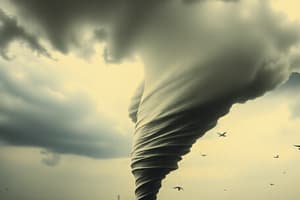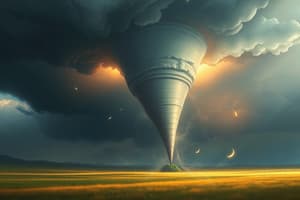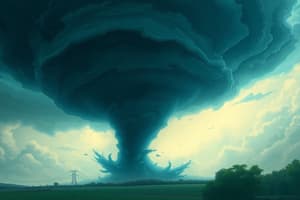Podcast
Questions and Answers
What primarily causes the formation of thunderstorms?
What primarily causes the formation of thunderstorms?
- Rapid cooling of warm air (correct)
- Frequent changes in temperature
- Sustained high humidity levels
- Stable atmospheric pressure
What is the main factor in the development of larger hailstones?
What is the main factor in the development of larger hailstones?
- Warm rain showers
- Strong updrafts (correct)
- Low atmospheric pressure
- High humidity levels
What role does lightning play during a thunderstorm?
What role does lightning play during a thunderstorm?
- It breaks down cumulonimbus clouds
- It serves as a heat source for the storm
- It provides moisture to fuel the storm
- It is a discharge of electricity (correct)
Which precaution is recommended during a thunderstorm?
Which precaution is recommended during a thunderstorm?
How does weather radar assist during thunderstorms?
How does weather radar assist during thunderstorms?
What is a crucial environmental condition required for hurricane formation?
What is a crucial environmental condition required for hurricane formation?
Which scale is used to categorize tornadoes based on the damage they cause?
Which scale is used to categorize tornadoes based on the damage they cause?
What meteorological phenomenon helps to maintain a hurricane's rotation?
What meteorological phenomenon helps to maintain a hurricane's rotation?
Which of the following is NOT typically associated with thunderstorms?
Which of the following is NOT typically associated with thunderstorms?
What is the minimum sea surface temperature needed for hurricane formation?
What is the minimum sea surface temperature needed for hurricane formation?
What type of weather system primarily utilizes Doppler radar and trained spotters for detection?
What type of weather system primarily utilizes Doppler radar and trained spotters for detection?
What is a significant risk associated with hurricanes that can lead to catastrophic damage?
What is a significant risk associated with hurricanes that can lead to catastrophic damage?
Which of the following protective measures is recommended in preparation for a hurricane?
Which of the following protective measures is recommended in preparation for a hurricane?
What does the CCL stand for in relation to thunderstorm development?
What does the CCL stand for in relation to thunderstorm development?
Which factor primarily helps initiate thunderstorms at the mesoscale?
Which factor primarily helps initiate thunderstorms at the mesoscale?
What type of thunderstorm is characterized by having a small vertical wind shear?
What type of thunderstorm is characterized by having a small vertical wind shear?
Which characteristic is NOT associated with multicell thunderstorms?
Which characteristic is NOT associated with multicell thunderstorms?
What influences the potential for severe convection during a thunderstorm?
What influences the potential for severe convection during a thunderstorm?
What is an indicator of potential convective activity in the atmosphere?
What is an indicator of potential convective activity in the atmosphere?
What occurs when the wind speed increases or changes direction with height?
What occurs when the wind speed increases or changes direction with height?
How does positive vorticity advection (PVA) help in thunderstorm prediction?
How does positive vorticity advection (PVA) help in thunderstorm prediction?
What characteristic is associated with a mesocyclone in a thunderstorm?
What characteristic is associated with a mesocyclone in a thunderstorm?
How do flash floods relate to thunderstorms?
How do flash floods relate to thunderstorms?
What role does atmospheric instability play in thunderstorm development?
What role does atmospheric instability play in thunderstorm development?
What is the expected behavior of thunderstorms that penetrate a convective cap?
What is the expected behavior of thunderstorms that penetrate a convective cap?
What is the significance of storm relative shear in the sub-cloud layer for tornado development?
What is the significance of storm relative shear in the sub-cloud layer for tornado development?
What is a defining characteristic of ordinary thunderstorms?
What is a defining characteristic of ordinary thunderstorms?
What type of thunderstorms makes up the majority of all thunderstorms?
What type of thunderstorms makes up the majority of all thunderstorms?
What enhances the inflow into a main updraft, affecting the longevity of a thunderstorm?
What enhances the inflow into a main updraft, affecting the longevity of a thunderstorm?
What characterizes single-cell thunderstorms?
What characterizes single-cell thunderstorms?
Which stage of a thunderstorm is characterized by the heaviest rainfall?
Which stage of a thunderstorm is characterized by the heaviest rainfall?
What is a significant feature of multicell thunderstorms?
What is a significant feature of multicell thunderstorms?
What is typically true about the air mass thunderstorm?
What is typically true about the air mass thunderstorm?
During which stage does the downdraft completely take over the cloud?
During which stage does the downdraft completely take over the cloud?
Which characteristic describes a supercell thunderstorm?
Which characteristic describes a supercell thunderstorm?
What occurs due to the interaction of parent thunderstorm outflows and warm, moist inflow?
What occurs due to the interaction of parent thunderstorm outflows and warm, moist inflow?
What is the main implication of high instability in air mass thunderstorms?
What is the main implication of high instability in air mass thunderstorms?
What primarily drives the formation of winds in a low-pressure area?
What primarily drives the formation of winds in a low-pressure area?
What is the maximum storm surge depth that can occur during a hurricane?
What is the maximum storm surge depth that can occur during a hurricane?
Which scale measures the strength of tornadoes based on the damage they cause?
Which scale measures the strength of tornadoes based on the damage they cause?
What happens to moist air as it warms over the ocean during hurricane formation?
What happens to moist air as it warms over the ocean during hurricane formation?
What range of categories does the Saffir-Simpson Scale use to classify tropical cyclones?
What range of categories does the Saffir-Simpson Scale use to classify tropical cyclones?
What is the minimum sustained wind speed for a tropical storm to be classified as a hurricane?
What is the minimum sustained wind speed for a tropical storm to be classified as a hurricane?
Which of the following best describes the initial process leading to the formation of a thunderstorm?
Which of the following best describes the initial process leading to the formation of a thunderstorm?
What distinguishes a tornado from a thunderstorm?
What distinguishes a tornado from a thunderstorm?
Which basin is generally NOT associated with hurricane formation?
Which basin is generally NOT associated with hurricane formation?
What hazardous phenomenon can occur during a thunderstorm?
What hazardous phenomenon can occur during a thunderstorm?
What causes the winds in a hurricane to become more powerful?
What causes the winds in a hurricane to become more powerful?
Which of the following conditions is essential for tornado formation?
Which of the following conditions is essential for tornado formation?
During what stage does a thunderstorm usually produce the heaviest precipitation?
During what stage does a thunderstorm usually produce the heaviest precipitation?
Flashcards
Thunderstorm Formation
Thunderstorm Formation
Warm, moist air rises, cools, and forms cumulonimbus clouds, leading to updrafts and downdrafts and electrical charges.
Hail Formation
Hail Formation
Water freezes in strong updrafts within thunderstorms, creating ice pellets that grow larger as they cycle through updrafts.
Lightning
Lightning
A release of electricity between clouds or clouds and the ground, often accompanied by a flash of light and a loud clap of thunder.
Severe Thunderstorms
Severe Thunderstorms
Signup and view all the flashcards
Weather Radar
Weather Radar
Signup and view all the flashcards
Tornadoes
Tornadoes
Signup and view all the flashcards
Wind Shear
Wind Shear
Signup and view all the flashcards
Enhanced Fujita Scale (EF Scale)
Enhanced Fujita Scale (EF Scale)
Signup and view all the flashcards
Hurricanes
Hurricanes
Signup and view all the flashcards
Storm Surge
Storm Surge
Signup and view all the flashcards
Saffir-Simpson Hurricane Wind Scale
Saffir-Simpson Hurricane Wind Scale
Signup and view all the flashcards
Thunderstorms
Thunderstorms
Signup and view all the flashcards
What is a mesocyclone?
What is a mesocyclone?
Signup and view all the flashcards
What is wind shear?
What is wind shear?
Signup and view all the flashcards
What is a squall line?
What is a squall line?
Signup and view all the flashcards
What is a multicell thunderstorm?
What is a multicell thunderstorm?
Signup and view all the flashcards
What is a supercell thunderstorm?
What is a supercell thunderstorm?
Signup and view all the flashcards
What is an updraft?
What is an updraft?
Signup and view all the flashcards
What is a downdraft?
What is a downdraft?
Signup and view all the flashcards
What is convection?
What is convection?
Signup and view all the flashcards
Convection Temperature
Convection Temperature
Signup and view all the flashcards
Low-level Jet's Role in Thunderstorm Formation
Low-level Jet's Role in Thunderstorm Formation
Signup and view all the flashcards
Synoptic Scale Ascent and Thunderstorms
Synoptic Scale Ascent and Thunderstorms
Signup and view all the flashcards
Wind Shear in Thunderstorms
Wind Shear in Thunderstorms
Signup and view all the flashcards
Single-Cell Storm
Single-Cell Storm
Signup and view all the flashcards
Multicell Storm
Multicell Storm
Signup and view all the flashcards
Positive Vorticity Advection (PVA)
Positive Vorticity Advection (PVA)
Signup and view all the flashcards
Wind Shear and Storm Severity
Wind Shear and Storm Severity
Signup and view all the flashcards
Single-cell Thunderstorm
Single-cell Thunderstorm
Signup and view all the flashcards
Multicell Thunderstorm
Multicell Thunderstorm
Signup and view all the flashcards
Supercell Thunderstorm
Supercell Thunderstorm
Signup and view all the flashcards
Vertical Shear
Vertical Shear
Signup and view all the flashcards
Cumulus Stage
Cumulus Stage
Signup and view all the flashcards
Mature Stage
Mature Stage
Signup and view all the flashcards
Dissipating Stage
Dissipating Stage
Signup and view all the flashcards
Squall Line
Squall Line
Signup and view all the flashcards
Hurricane Formation
Hurricane Formation
Signup and view all the flashcards
Saffir-Simpson Scale
Saffir-Simpson Scale
Signup and view all the flashcards
Coriolis Effect
Coriolis Effect
Signup and view all the flashcards
EF Scale
EF Scale
Signup and view all the flashcards
What is a tornado?
What is a tornado?
Signup and view all the flashcards
What is a hurricane?
What is a hurricane?
Signup and view all the flashcards
What is a thunderstorm?
What is a thunderstorm?
Signup and view all the flashcards
How do tornadoes form?
How do tornadoes form?
Signup and view all the flashcards
How do hurricanes form?
How do hurricanes form?
Signup and view all the flashcards
When are thunderstorms most hazardous?
When are thunderstorms most hazardous?
Signup and view all the flashcards
Why are tornadoes dangerous?
Why are tornadoes dangerous?
Signup and view all the flashcards
What are the characteristics of hurricanes?
What are the characteristics of hurricanes?
Signup and view all the flashcards
Study Notes
Tornadoes
- Tornadoes are violently rotating columns of air that extend from a thunderstorm to the ground.
- They are characterized by a funnel cloud or condensation funnel.
- Formation requires specific atmospheric conditions, including instability, wind shear, and a lifting mechanism.
- Wind shear is a significant factor; it causes horizontal rotation in the atmosphere, which can be tilted vertically by rising air currents.
- Tornadoes vary significantly in intensity, with the Enhanced Fujita Scale (EF Scale) used to categorize them based on damage.
- EF ratings range from EF0 (light damage) to EF5 (extreme damage).
- Tornadoes are most common in the "Tornado Alley" region of the central United States, but can occur globally.
- They develop most frequently during the spring and summer months.
- Warning systems rely on Doppler radar, weather observations, and trained spotters to detect and predict the development of tornadoes.
- Warning times are crucial for seeking shelter.
- Safety measures include seeking shelter in a storm cellar or interior room on the lowest floor away from windows.
Hurricanes
- Hurricanes are powerful rotating storms that form over warm ocean waters.
- They are characterized by strong winds, heavy rainfall, and storm surge.
- Formation requires sea surface temperatures of at least 26.5°C (80°F) to provide the necessary energy.
- A pre-existing weather disturbance (e.g., tropical depression) is usually needed to initiate the process.
- The Coriolis effect, caused by the Earth's rotation, plays a key role in maintaining a hurricane's spin.
- Hurricanes are intensely powerful systems, categorized using the Saffir-Simpson Hurricane Wind Scale.
- Categories range from Category 1 (weak winds) to Category 5 (catastrophic winds).
- Hurricanes can cause extensive damage due to strong winds, flooding, and storm surge.
- Storm surge is a dangerous rise in sea level from a combination of high winds and low-pressure systems.
- Predicting hurricane paths is crucial for issuing warnings and enabling evacuations.
- Early warning systems use sophisticated satellite imagery, weather radar, and numerical weather prediction models.
- Protective measures include proper preparation, evacuation of vulnerable areas, and reinforcing structures against high winds and storm surge.
Thunderstorms
- Thunderstorms are storms characterized by the presence of lightning and thunder.
- They are typically associated with heavy rain, strong winds, and hail.
- Thunderstorms develop when warm, moist air rises rapidly, cools, and condenses, forming cumulonimbus clouds.
- The rapid cooling creates updrafts and downdrafts, leading to electrical charges and storms.
- Hailstones form when water freezes in the strong updrafts and downdrafts within the thunderstorm clouds.
- The strength of the updrafts is crucial for the development of larger hail.
- Severe thunderstorms can produce strong winds, damaging hail, and tornadoes.
- Lightning is a discharge of electricity between clouds or between clouds and the ground.
- Lightning can be extremely dangerous to both property and life.
- Safety precautions during thunderstorms include avoiding contact with water and metal objects and promptly seeking shelter.
- Weather forecasts and monitoring tools help predict the likelihood and intensity of thunderstorms.
- Weather radar plays a crucial role in detecting approaching storms and tracking their movement.
- Thunderstorms can be single-cell, multicell, or supercell.
- Single-cell thunderstorms are relatively short-lived (30-60 minutes), and not very intense.
- Multicell storms are composed of multiple cells and last longer than the single-cell variety.
- Supercell thunderstorms are the most intense, and potentially the most damaging; they are associated with rotating updrafts.
- Supercells are associated with long-lived storms, strong winds, hail, and potentially tornadoes.
- Air mass thunderstorms form away from frontal systems, are usually non-severe, and form where moist and unstable conditions exist with little vertical shear.
- Pulse severe storms can result from these thunderstorms, with brief, high winds and hail due to high instability.
- Cumulus stage: Starts with a warm plume of rising air, with increasing updraft velocity. Entrainment pulls outside air into the cloud. Supercooled water droplets are carried to heights above the freezing level.
- Mature stage: Heaviest rains occur. Downdraft initiated by frictional drag of falling raindrops causes evaporative cooling and negative buoyancy and eventual anvil top formation.
Studying That Suits You
Use AI to generate personalized quizzes and flashcards to suit your learning preferences.





